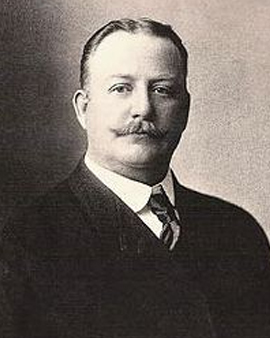The barren ground is whirled up to fine dust by the stomping hooves of the noble steed. The rider's upper body is bent forward; it is a scene full of dynamics and power. It is also a picture of the kind seen not only in America but also in the rest of the world when people talk about the so-called Wild West. Even if we know today that many of these seemingly typical depictions were too romanticised, the artists of the second half of the 19th century still shaped all of our images of the conquest of the West.
Artists like Frederic Remington. Today he is very well known for his illustrations of the Wild West and those who know his complete works will find few other motifs. Remington was an East Coast resident through and through, born and educated in New York and at Yale University in Connecticut. Remington had his first contact with the West of the country at the age of 19, when he wanted to buy a ranch in Montana. The project failed due to a lack of financial resources, but the vastness of the country, which he was able to experience there with his own eyes as well as skirmishes between the Native Americans and the US cavalry, was to have a lasting influence on his work from then on. In fact, Remington had more direct experience with his subject matter through his now more frequent travels than many of his artist colleagues, who also painted scenes from the Wild West.
Remington's work lives above all from the representation of what most viewers do not know from their own experience. His choice of motifs and his unmistakable talent for the right perspective, as well as his ability to depict things in a way that is both vivid and artistic, made him a correspondent for influential weekly magazines. His pictures were widely distributed. Even President Theodore Roosevelt, himself a friend of the landscapes of the West, took note of them and noticed that the cowboys and ranchers, the horses and herds of cattle come alive in Remington's pictures. Towards the end of his career, he increasingly devoted himself to sculpture, with similar motifs also being a priority in this art. Remington also created a remarkable series of paintings in which he made the darkness and the colours of the night his subject.
×





_-_(MeisterDrucke-1087581).jpg)
_-_(MeisterDrucke-1087581).jpg)
_-_(MeisterDrucke-1082594).jpg)
_-_(MeisterDrucke-1082594).jpg)
.jpg)
.jpg)
.jpg)
.jpg)
.jpg)
.jpg)
_1889-90_(oil_on_canvas)_-_(MeisterDrucke-901370).jpg)
_1889-90_(oil_on_canvas)_-_(MeisterDrucke-901370).jpg)
.jpg)
.jpg)
_-_(MeisterDrucke-1089752).jpg)
_-_(MeisterDrucke-1089752).jpg)
.jpg)
.jpg)
_-_(MeisterDrucke-1083649).jpg)
_-_(MeisterDrucke-1083649).jpg)
 Making his Way Across New Mexico from The Great American Explorers 1905 - (MeisterDrucke-68724).jpg)
 Making his Way Across New Mexico from The Great American Explorers 1905 - (MeisterDrucke-68724).jpg)
_-_(MeisterDrucke-1087572).jpg)
_-_(MeisterDrucke-1087572).jpg)
.jpg)
.jpg)
.jpg)
.jpg)
.jpg)
.jpg)
.jpg)
.jpg)
.jpg)
.jpg)
.jpg)
.jpg)
.jpg)
.jpg)
.jpg)
.jpg)
_c1902_-_(MeisterDrucke-566035).jpg)
_c1902_-_(MeisterDrucke-566035).jpg)
.jpg)
.jpg)
.jpg)
.jpg)
.jpg)
.jpg)
.jpg)
.jpg)
.jpg)
.jpg)
_c1885_(wc_on_paper)_-_(MeisterDrucke-578790).jpg)
_c1885_(wc_on_paper)_-_(MeisterDrucke-578790).jpg)
_-_(MeisterDrucke-1083648).jpg)
_-_(MeisterDrucke-1083648).jpg)
.jpg)
.jpg)
_-_(MeisterDrucke-310567).jpg)
_-_(MeisterDrucke-310567).jpg)
.jpg)
.jpg)
.jpg)
.jpg)
.jpg)
.jpg)
.jpg)
.jpg)
.jpg)
.jpg)
_-_(MeisterDrucke-1090054).jpg)
_-_(MeisterDrucke-1090054).jpg)
.jpg)
.jpg)
.jpg)
.jpg)
.jpg)
.jpg)
.jpg)
.jpg)
.jpg)
.jpg)
.jpg)
.jpg)
.jpg)
.jpg)
 1908 - (MeisterDrucke-632518).jpg)
 1908 - (MeisterDrucke-632518).jpg)
.jpg)
.jpg)
.jpg)
.jpg)
.jpg)
.jpg)
.jpg)
.jpg)
.jpg)
.jpg)
.jpg)
.jpg)
_-_(MeisterDrucke-902734).jpg)
_-_(MeisterDrucke-902734).jpg)
.jpg)
.jpg)
_-_(MeisterDrucke-1082592).jpg)
_-_(MeisterDrucke-1082592).jpg)
_1897_-_(MeisterDrucke-578792).jpg)
_1897_-_(MeisterDrucke-578792).jpg)
.jpg)
.jpg)
.jpg)
.jpg)
.jpg)
.jpg)
_1892-94_(wc_and_pen_ink_on_paper)_-_(MeisterDrucke-578781).jpg)
_1892-94_(wc_and_pen_ink_on_paper)_-_(MeisterDrucke-578781).jpg)
.jpg)
.jpg)
_1908_(oil_on_composition_board)_-_(MeisterDrucke-383930).jpg)
_1908_(oil_on_composition_board)_-_(MeisterDrucke-383930).jpg)
.jpg)
.jpg)
.jpg)
.jpg)
_1892-93_-_(MeisterDrucke-578929).jpg)
_1892-93_-_(MeisterDrucke-578929).jpg)
.jpg)
.jpg)
_1901_-_(MeisterDrucke-578789).jpg)
_1901_-_(MeisterDrucke-578789).jpg)
.jpg)
.jpg)
.jpg)
.jpg)
.jpg)
.jpg)
.jpg)
.jpg)
_-_(MeisterDrucke-578930).jpg)
_-_(MeisterDrucke-578930).jpg)
.jpg)
.jpg)
_1895_-_(MeisterDrucke-578780).jpg)
_1895_-_(MeisterDrucke-578780).jpg)
_from_Harpers_W_-_(MeisterDrucke-1090114).jpg)
_from_Harpers_W_-_(MeisterDrucke-1090114).jpg)
.jpg)
.jpg)
.jpg)
.jpg)
.jpg)
.jpg)
.jpg)
.jpg)
.jpg)
.jpg)
_c1896_-_(MeisterDrucke-578788).jpg)
_c1896_-_(MeisterDrucke-578788).jpg)
.jpg)
.jpg)
_-_(MeisterDrucke-1090146).jpg)
_-_(MeisterDrucke-1090146).jpg)
.jpg)
.jpg)
.jpg)
.jpg)
.jpg)
.jpg)
.jpg)
.jpg)
.jpg)
.jpg)
.jpg)
.jpg)
.jpg)
.jpg)
.jpg)
.jpg)
.jpg)
.jpg)
.jpg)
.jpg)
.jpg)
.jpg)
.jpg)
.jpg)
_-_(MeisterDrucke-1555178).jpg)
_-_(MeisterDrucke-1555178).jpg)
_1899_-_(MeisterDrucke-578787).jpg)
_1899_-_(MeisterDrucke-578787).jpg)
 - (MeisterDrucke-637284).jpg)
 - (MeisterDrucke-637284).jpg)
.jpg)
.jpg)
.jpg)
.jpg)
.jpg)
.jpg)
.jpg)
.jpg)






